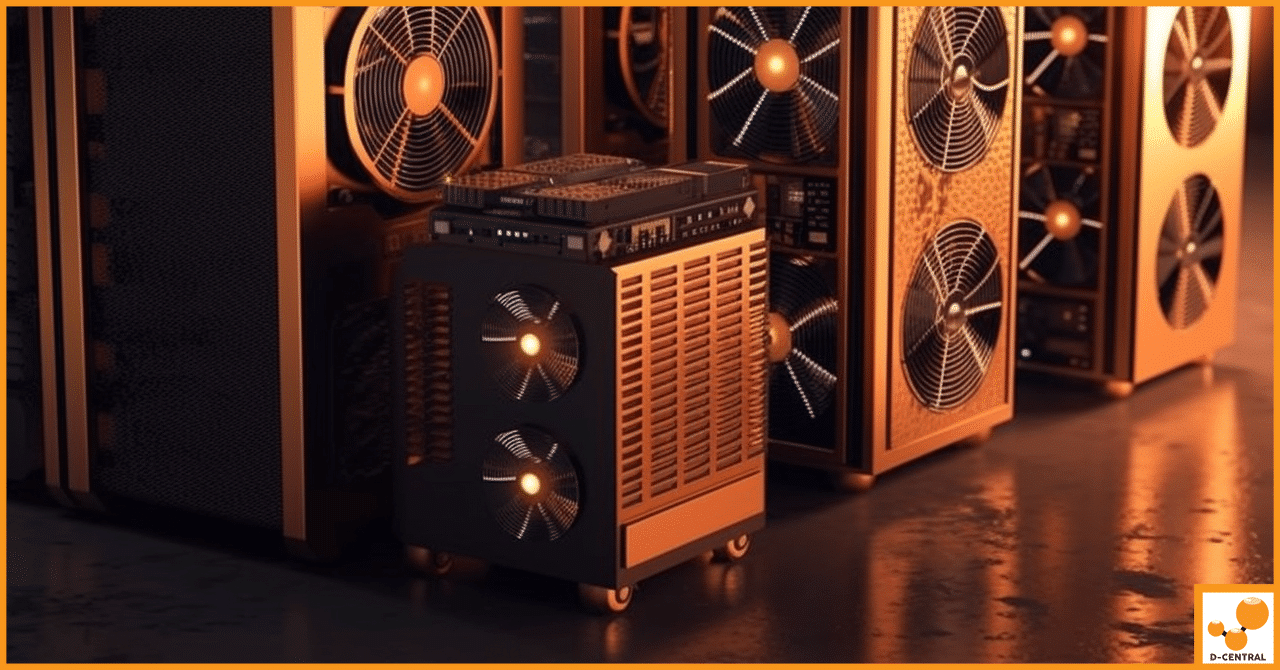
Mastering the Heat Best Practices for Efficient Bitcoin Mining Heat Management
In the dynamic world of cryptocurrency, Bitcoin mining has emerged as a lucrative yet challenging endeavor. This process involves solving
4479 Desserte Nord Autoroute 440, Laval, QC H7P 6E2

In the dynamic world of cryptocurrency mining, the quest for efficiency and profitability has led to the advent of Application-Specific Integrated Circuit (ASIC) miners, a pivotal innovation that has significantly shaped the mining landscape. Unlike their predecessors — CPUs and GPUs — ASIC miners are designed with a singular focus: to mine cryptocurrencies with unparalleled efficiency. This specialization not only marks a leap in the technological evolution of mining hardware but also underscores the critical role ASIC miners play in the cryptocurrency ecosystem.
ASIC miners are the backbone of cryptocurrency mining, providing the computational power necessary to secure blockchain networks and validate transactions. Their ability to perform complex cryptographic calculations at high speeds and with remarkable energy efficiency has made them indispensable in the mining community. However, the high-performance operation of ASIC miners raises questions about their durability and operational lifespan — factors that are crucial for miners who aim to maximize their investment in this competitive domain.
The lifespan of an ASIC miner is influenced by a myriad of factors, ranging from the inherent quality of its manufacturing to the conditions under which it operates. Manufacturing quality, encompassing the components used and the precision of the assembly process, sets the foundation for a miner’s durability. The operating environment, including factors such as temperature, humidity, and airflow, directly impacts the efficiency and longevity of the hardware. Furthermore, usage intensity and practices like overclocking can accelerate wear and tear, potentially shortening the miner’s operational life. Understanding these factors is essential for anyone involved in cryptocurrency mining, whether they are navigating the complexities of setting up a mining operation or seeking to optimize the performance and lifespan of their existing hardware.
As we delve deeper into the intricacies of ASIC miners and their lifespan, it becomes evident that the pursuit of mining efficiency is balanced by the challenges of maintaining and prolonging the life of these specialized devices. This article aims to explore the lifespan of ASIC miners, shedding light on how long they last under various conditions and offering insights into maximizing their operational life. Through a comprehensive examination of the factors influencing ASIC miner lifespan, we endeavor to equip miners with the knowledge needed to make informed decisions, ensuring the sustainability and profitability of their mining operations.
An Application-Specific Integrated Circuit (ASIC) miner is a specialized piece of hardware designed exclusively for cryptocurrency mining. Unlike general-purpose processors such as CPUs (Central Processing Units) and GPUs (Graphics Processing Units), ASIC miners are engineered to perform the specific cryptographic calculations required by a particular blockchain protocol, making them incredibly efficient at mining certain types of cryptocurrencies.
The term “ASIC” itself reveals the core of what these devices are: circuits integrated into hardware for a specific application. In the context of cryptocurrency, that application is the mining process, which involves validating transactions and creating new blocks on a blockchain. The specificity of ASIC miners allows for unparalleled efficiency in this task, but it also means they are not versatile; an ASIC miner built for Bitcoin mining, for instance, cannot be repurposed for mining another cryptocurrency like Ethereum.
The evolution of ASIC miners is a testament to the rapid development and increasing competitiveness within the cryptocurrency mining industry. In the early days of Bitcoin, mining was possible with simple CPUs found in average home computers. As the network grew and the mining difficulty increased, miners sought more powerful hardware, leading to the adoption of GPUs and later FPGAs (Field-Programmable Gate Arrays), which offered better efficiency and speed.
However, the real game-changer came with the introduction of ASIC miners around 2013. These devices were designed from the ground up to optimize the mining process for specific algorithms, offering exponential increases in hashing power and energy efficiency compared to their predecessors. This leap in technology not only escalated the mining arms race but also significantly increased the difficulty and entry barrier for new miners, cementing ASIC miners as the de facto standard for serious cryptocurrency mining operations.
At the heart of an ASIC miner is the ASIC chip, which contains the circuitry necessary to execute the hashing algorithms required for mining cryptocurrencies. These chips are designed to perform the specific calculations needed to mine a particular cryptocurrency, making them incredibly efficient at their designated task.
The transition to ASIC mining has profoundly impacted the cryptocurrency mining landscape, prioritizing efficiency and specialization. As the industry continues to evolve, the role of ASIC miners remains central, driving forward the endless pursuit of faster, more efficient mining technology.
The lifespan of an ASIC miner is a critical consideration for anyone involved in cryptocurrency mining. While these devices are engineered for efficiency and performance, their operational life can vary significantly based on several key factors. Understanding these can help miners make informed decisions to maximize their hardware’s longevity and, by extension, their investment.
Impact of Build Quality and Component Selection on Durability
The foundation of an ASIC miner’s lifespan begins with its manufacturing quality. High-quality components and precise assembly processes contribute significantly to the durability and reliability of the miner. Premium-grade materials can withstand the rigors of continuous operation, while precision in manufacturing ensures that each part of the miner functions as intended, reducing the likelihood of failures.
Manufacturers who invest in quality control and advanced manufacturing technologies tend to produce ASIC miners that not only perform better but also last longer. The choice of components, from the ASIC chips themselves to the power supply units and cooling systems, plays a pivotal role in determining how well a miner can handle continuous, intensive mining operations.
Insights from Leading ASIC Miner Manufacturers
Leading manufacturers like Bitmain, Canaan, and MicroBT share insights into their production processes, emphasizing the importance of rigorous testing and quality assurance. These companies often highlight their commitment to using high-grade materials and components to ensure that their miners are both efficient and durable. By adhering to high manufacturing standards, these manufacturers aim to provide miners with reliable hardware that maximizes uptime and profitability.
The Role of Temperature, Humidity, and Airflow in Miner Longevity
The environment in which an ASIC miner operates has a profound impact on its lifespan. Optimal operating conditions can significantly extend the life of mining hardware, while adverse conditions can accelerate wear and tear.
Case Studies on Environmental Control in Mining Operations
Several case studies from successful mining operations illustrate the importance of environmental control. For instance, some large-scale mining farms use advanced cooling systems and humidity control to create an optimal operating environment. These measures not only extend the lifespan of their ASIC miners but also enhance their overall efficiency and performance.
How Operational Intensity Affects Wear and Tear
Continuous, intensive operation puts a strain on ASIC miners, potentially leading to increased wear and tear. While these devices are designed for constant use, the rate at which they are pushed can affect their longevity. Regular maintenance and occasional downtime can help mitigate these effects and prolong the miner’s operational life.
The Pros and Cons of Overclocking for Performance vs. Lifespan
Overclocking, or running a miner at higher speeds than its standard configuration, can increase its hash rate and potential earnings. However, this comes at the cost of higher power consumption and increased heat output, which can accelerate wear and tear on the hardware. Miners must weigh the short-term benefits of overclocking against the potential for reduced lifespan and increased maintenance costs.
In conclusion, the lifespan of an ASIC miner is influenced by a combination of manufacturing quality, operating environment, and usage intensity. By paying close attention to these factors, miners can optimize their operations for both performance and longevity, ensuring that their investment in ASIC mining hardware remains profitable over the long term.
Understanding the average lifespan of ASIC miners is crucial for anyone involved in cryptocurrency mining, from individual hobbyists to large-scale mining operations. This knowledge helps in planning for hardware upgrades, calculating return on investment, and developing maintenance schedules. However, determining an exact lifespan can be challenging due to the variability in manufacturing quality, operating conditions, and usage patterns. Here, we explore both the manufacturers’ lifespan estimates and real-world data to provide a comprehensive view.
Manufacturers of ASIC miners, such as Bitmain, Whatsminer (MicroBT), and Canaan, provide lifespan estimates based on optimal operating conditions and average usage intensity. These estimates often range from 3 to 5 years, a period during which the hardware is expected to operate efficiently without significant loss in performance or failure, assuming it is maintained properly and operated within recommended environmental parameters.
It’s important to note that these estimates assume that the miners are kept in ideal conditions — something that may not always be feasible in real-world scenarios.
Real-world data on ASIC miner lifespans can vary significantly from manufacturer estimates due to a wide range of operating environments and maintenance practices. Mining farms and individual miners have reported operational lifespans that both exceed and fall short of the expected 3 to 5 years.
The discrepancy between manufacturer lifespan estimates and real-world data underscores the importance of maintenance. Regular cleaning to remove dust and debris, ensuring adequate airflow, and keeping the mining environment within recommended temperature and humidity ranges are critical for prolonging the life of ASIC miners.
While manufacturers provide a general guideline for the lifespan of ASIC miners, real-world experiences show that diligent maintenance and environmental control are key to maximizing hardware longevity. By adopting best practices for miner care, operators can often extend the life of their equipment beyond the initial estimates, ensuring sustained profitability from their mining investments.
Ensuring the longevity of ASIC miners is paramount for maximizing the return on investment in the competitive landscape of cryptocurrency mining. By adhering to best practices for operating conditions, maintenance, and security, miners can significantly extend the operational life of their hardware. Here’s a comprehensive guide to achieving this.
Creating the Ideal Mining Environment
The environment in which ASIC miners operate plays a crucial role in their longevity. The ideal mining environment minimizes stress on the hardware, allowing it to operate within its optimal performance parameters.
Innovative Solutions for Heat Management and Cooling
Step-by-Step Maintenance Routine for ASIC Miners
Regular maintenance is essential to keep ASIC miners running smoothly. Here’s a routine to follow:
Recommended Tools and Practices for Effective Cleaning
The Importance of Keeping ASIC Miner Firmware Up to Date
Manufacturers frequently release firmware updates that can improve performance, add new features, and patch security vulnerabilities. Keeping the firmware of your ASIC miner up to date ensures that it operates efficiently and remains secure against potential threats.
Security Practices to Protect Mining Hardware from Threats
By meticulously following these guidelines for optimal operating conditions, routine maintenance, and software security, miners can significantly prolong the lifespan of their ASIC miners. This not only ensures sustained mining efficiency but also protects the investment made into the mining hardware, contributing to a more profitable mining operation over time.
The journey through the intricacies of ASIC miner maintenance and operation underscores the delicate balance between maximizing efficiency and prolonging hardware lifespan in the realm of cryptocurrency mining. We’ve navigated through the essential practices—from maintaining optimal operating conditions and conducting routine maintenance to ensuring software is up-to-date and secure. These practices are not just routines; they are investments in the longevity and productivity of your mining operations.
Adopting responsible mining practices is not only beneficial for individual miners and mining operations but is also crucial for the long-term sustainability of the cryptocurrency ecosystem. By ensuring that ASIC miners are maintained properly and operated efficiently, we can minimize waste, reduce the environmental impact, and make the mining process as cost-effective as possible. This approach fosters a healthier, more sustainable mining environment that benefits all stakeholders in the cryptocurrency space.
For those looking to delve deeper into the world of ASIC mining or seeking to optimize their current operations, D-Central Technologies offers a wealth of services and solutions tailored to your needs. From providing top-tier ASIC miners and maintenance services to offering expert consultations on creating the ideal mining setup, D-Central Technologies is your partner in navigating the complexities of cryptocurrency mining.
We invite you to share your experiences, feedback, or any questions you may have about ASIC mining. Whether you’re curious about starting your mining journey or looking to enhance your existing operations, the community and experts at D-Central Technologies are here to support and guide you. Let’s continue the conversation and work together towards more efficient, sustainable, and profitable mining practices.
In embracing these principles and practices, we not only safeguard our investments but also contribute to the broader vision of a sustainable and thriving cryptocurrency mining industry.
What is an ASIC miner?
An Application-Specific Integrated Circuit (ASIC) miner is a specialized hardware designed exclusively for cryptocurrency mining. It’s engineered to perform the specific cryptographic calculations required by a particular blockchain protocol, enabling highly efficient mining of cryptocurrencies like Bitcoin.
How does the lifespan of an ASIC miner compare to CPUs and GPUs?
ASIC miners, due to their specialized design, tend to have a more focused and efficient operation compared to CPUs and GPUs. While ASIC miners are not versatile and are dedicated to mining specific cryptocurrencies, they offer greater energy efficiency and a higher hash rate. Depending on various factors, such as manufacturing quality, operating conditions, and maintenance, ASIC miners can have a lifespan ranging from 3 to 5 years, potentially exceeding this with optimal care.
What factors influence the lifespan of an ASIC miner?
The lifespan of an ASIC miner is influenced by its manufacturing quality, operating environment, and usage intensity. Factors such as the quality of components, temperature, humidity, airflow, and operational intensity, including practices like overclocking, can significantly impact the miner’s durability and operational life.
What are the ideal operating conditions for ASIC miners?
The ideal operating conditions for ASIC miners include maintaining ambient temperatures within the manufacturer’s recommended range (typically 20°C to 25°C), keeping humidity levels between 30% to 40%, and ensuring proper ventilation for effective heat dissipation. These conditions help prevent overheating, corrosion, and electrical shorts, thereby extending the miner’s lifespan.
How can the lifespan of an ASIC miner be prolonged?
Prolonging the lifespan of an ASIC miner involves maintaining optimal operating conditions, performing regular maintenance (such as cleaning dust and checking connections), ensuring adequate cooling, and updating the miner’s firmware for optimal performance and security. Following these guidelines can significantly enhance the durability and operational life of an ASIC miner.
Where can I find services and solutions for optimizing my ASIC mining operations?
D-Central Technologies offers a range of services and solutions tailored for cryptocurrency mining, including top-tier ASIC miners, maintenance services, and expert consultations to help you set up and optimize your mining operations. They provide specialized support for both new and experienced miners looking to improve their mining efficiency and profitability.
DISCLAIMER: D-Central Technologies and its associated content, including this blog, do not serve as financial advisors or official investment advisors. The insights and opinions shared here or by any guests featured in our content are provided purely for informational and educational purposes. Such communications should not be interpreted as financial, investment, legal, tax, or any form of specific advice. We are committed to advancing the knowledge and understanding of Bitcoin and its potential impact on society. However, we urge our community to proceed with caution and informed judgment in all related endeavors.
Related Posts

In the dynamic world of cryptocurrency, Bitcoin mining has emerged as a lucrative yet challenging endeavor. This process involves solving

In the ever-evolving landscape of digital finance, Bitcoin mining has emerged as a crucial process that holds the fort for

In the rapidly evolving landscape of cryptocurrency mining, Application-Specific Integrated Circuit (ASIC) miners have emerged as the linchpin of efficiency